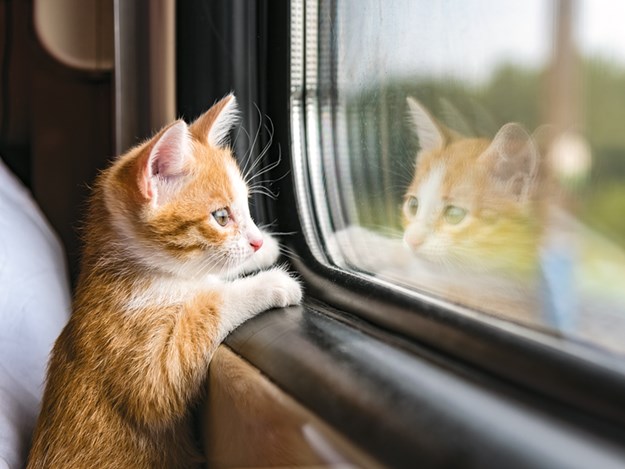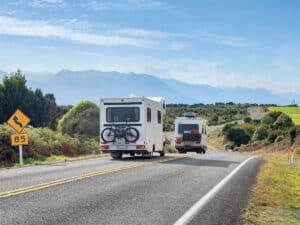Nicky’s ark
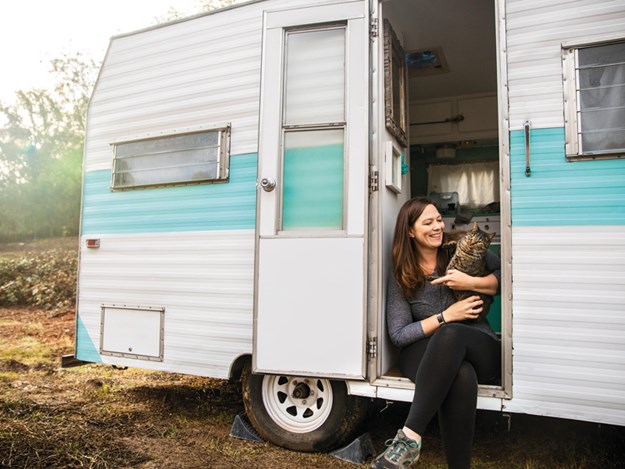
Three years on from the flash flood that threw her out of her home and into a life on the road, Nicky Kewish is a firm believer cats can adjust to motorhoming too. “I had no warning before the river burst its banks.
In just 10 minutes the water was waist high,” Nicky told me from Tairua North Beach in the Coromandel, where she was parked up in her seven-metre Coastal Motorhome surrounded by five dozing cats.
“The river flowed through the town for four days straight and took nine days to recede. I lost three cats and it took me up to two weeks to find the others. ”What Nicky, then owner of nine cats and a dog, was describing is the Edgecumbe flood caused by Cyclone Debbie on 6 April, 2017.
“I remember being a metre deep in water carrying a cat cage with two cats and a bag of clothes above my head. I remember thinking, you never know what life will throw at you; maybe it’s time to do something completely different.”
And that’s exactly what she did. Initially Nicky moved into her van, but later sold it and bought the motorhome she now shares with her feline family – Monkey, Tiffany, Spitfire, Fudge and Baby. Her 12-year-old dog Hawke made it through the disaster but died in April.
Another of Nicky’s cats has since died too “We’ve all been through a lot together. but now, I couldn’t be happier, to be honest. I love it. I just couldn’t go back to my old life after the flood. Life on the road with cats is wonderful. I couldn’t recommend it more highly.”
For other motorhomers keen to travel with cats, Nicky had one important tip. “My five are mostly indoor cats, which is probably quite unusual. But the motorhome has become their safe haven after the terror of the floods.
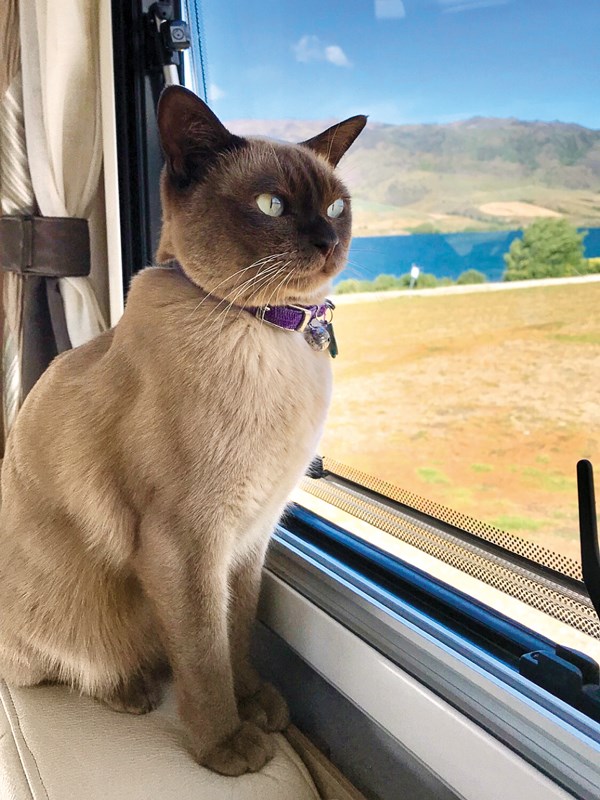 |
The key to travelling wtih pets is to put their needs first |
My main advice would be to work out your pets’ needs and design around them. “Changes I made to the locker under my bed included the installation of cat flaps and five big round peep holes. Converting the storage area to a cat-friendly hiding-hole reduces crowding and gives the cats a place to feel secure, as well as watch the world go by.”
A moggie in a Mitsubishi
Margaret Newell, husband Arthur and their four-year-old moggie Misty regularly hit the road in a nine-metre Mitsubishi Fuso bus. Shortly they’re headed to Ngawi in coastal Wairarapa.
“Misty loves travelling,” explained Margaret from home base in Paeroa. “She likes rolling in sand if we’re at the beach or playing in grass if we’re at the park. She’s totally attached to the bus. It’s her territory. She’s attached to us, too, of course. Wherever we go, she follows.”
Misty has a special area behind the driver’s seat to sleep in while travelling, toilets only in a litter box inside the bus and wears a collar and lead when the Newells are out and about exploring new places.
“She took a couple of weeks to adjust to the lead, but now I wouldn’t take her anywhere without it. It keeps her from wandering off and getting attacked by dogs. It’s part of her routine. In the morning she’ll meow to go outside, then wait patiently while we put on her collar and lead.”
Ears there and everywhere
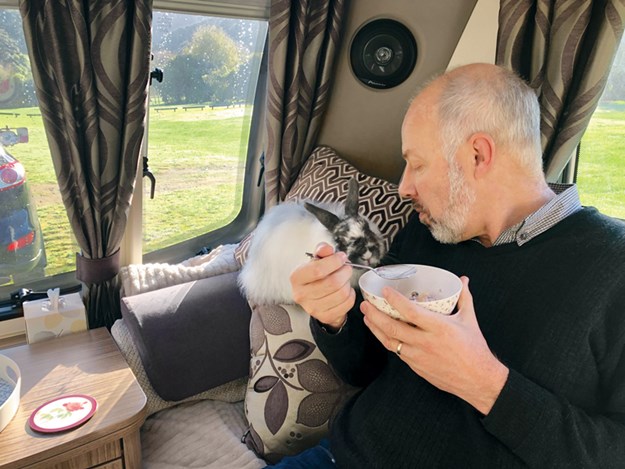 |
Sophia is part of the family |
Wellington couple Helen and Martin Swiney are the proud parents of Sophia, an 18-month-old Jersey Wooly rescue rabbit from the Newtown SPCA. Helen said the pair think long and hard about what to pack for Sophia when they go away in their 2015 Coachman caravan.
“Rabbits are great pets. But they’re more work than cats or dogs. They need a specific diet. You have to keep them safe from predators like stoats, cats and dogs. They need a lot of care. We love our Sophia – she lives inside permanently with us and regularly comes with us on holiday in the caravan.
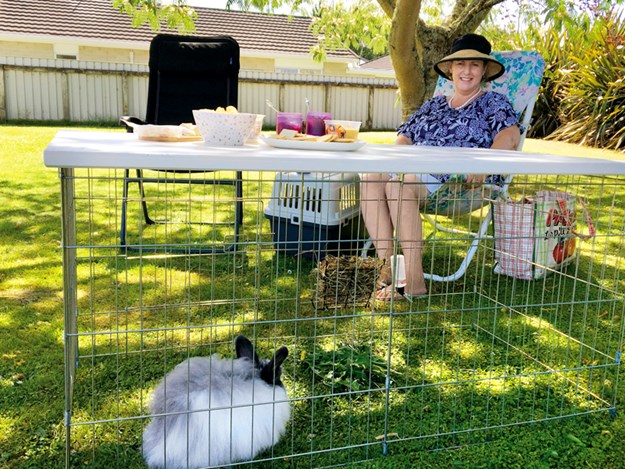 |
While Sophia loves time outdoors, she lives inside with Helen and Martin |
My friends call me the ‘mad bunny lady’. ”On the Swineys’ packing checklist is a travel-size hutch, a predator-proof run, fitted out with a wooden roof and shade cloth, plenty of hay, and food such as pellets and fresh kale.
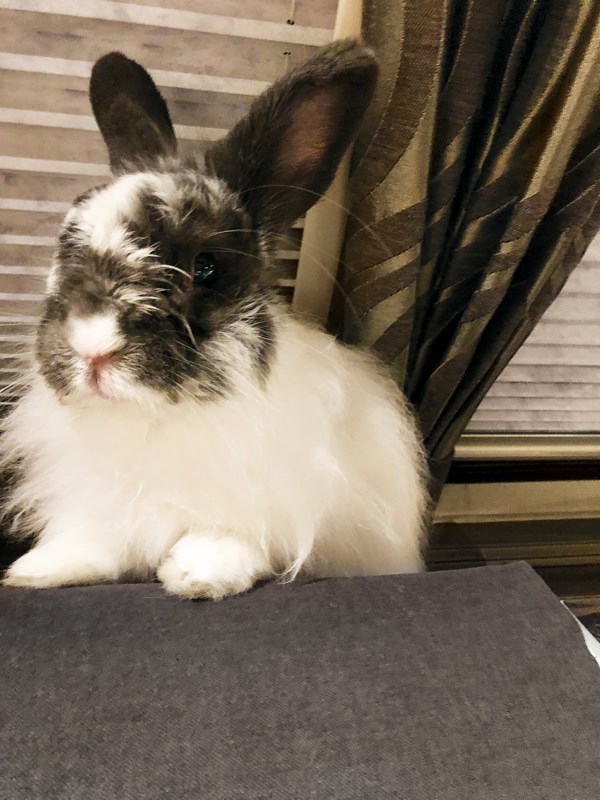
Other must-haves include a medical kit, a litter box and her travel case (that she sits in while they’re driving) and a pet stroller so Sophia can come with them to cafes. When they’re on the road, they tend to stop every two hours to give Sophia time to enjoy her run outside and to break up their journey with a cup of tea.
“Why wouldn’t she come on holiday with us? Not all rabbits travel well. But Sophia does. So, to me, not including her would be like leaving a member of the family behind.”
Veteran voyager
Shadow, Lynley Dewes’ 17-year-old cat, has been motorhoming with Lynley, her husband and their two dogs for three years. Lynley, owner of a nine-metre TrailLite motorhome, said she’s seeing more and more people at RV rallies travelling with cats.
“Shadow started out travelling in a cage,” said Lynley, “but he didn’t much like it, so now he sits in a fold-down seat between the passenger and driver. Before we head off somewhere, we put him in a harness that hooks to the seat by a lead.
It keeps him safe and prevents him from jumping on the driver’s knee. ”She’s since fitted Shadow with a collar and identity disc inscribed with the motorhome licence plate details and Lynley’s cellphone number, and slowly got him used to walking on a lead.
“Usually he walks the boundary of the park we’re in, sniffing everything as he goes. Once around, he’s pretty much finished and ready to go back to the motorhome. “The key to travelling with cats, I think, is to be relaxed. Try things out and see what works and what doesn’t. If you like the idea, give it a go.”
Free-range feline
Janeece Shieffelbien, owner of six-year-old rescue cat Indigo, agrees with that ‘just give it a go’ sentiment. She and her partner Shane began living full-time in their seven-metre Isuzu bus nearly two years ago.
“At the time we did wonder how the cat would cope. It’s been fine. Indigo is so bonded with us that she goes where we go – it’s as simple as that.” However, the day Indigo escaped from the bus without a harness or lead was a heart-stopper for Janeece.
“We just waited. About an hour later she was back. I can’t say I wasn’t really nervous. I was. But it changed our approach and we decided to let her come and go as she wants. Nowadays she’s 100 percent free range,” said Janeece.
Wanderer, the wild cat
Ebony Moore and her three-and-a-half-year-old cat Wanderer have been on the road together since 2017. “Wanderer was a wild kitten I picked up in Kawhia. She spent four days hidden behind the dashboard of my campervan before she finally came out to meet me.
We’ve been inseparable ever since. “I guess we’ve both gone through rough times. Her first six weeks of life were pretty touch-and-go. My 15-year-old sister suicided a few years ago, which is why I sold my coffee cart business and took up life on the road. Today things are better for us both. We travel the length of the country every year.
Ebony runs a business called Hygienitech NZ, where she cleans and sanitises mattresses. “In my spare time we go bush walking. Wanderer loves long walks in the bush and knows exactly when to run up a tree to avoid a scary dog and when to quietly stand still to sniff a friendly one.
“Wanderer is no ordinary cat. She’s free roaming. And she’s got a great social life thanks to her Facebook page. She’s been invited on a boat, to a 60th birthday party and often gets asked to go on dates with Facebook fans.
Ebony’s advice for travelling with cats? “I’d say be patient. Cats are independent. They need to know you’re not going to trap them. With Wanderer, if she disappears from the campervan for a while, I don’t panic. I just wait till she finds her way back.”
Extra story: Tom-Tom
"I live full-time in a 1985 Daihatsu Delta motorhome with my daughter and Tom-Tom, our 11-year-old-ginger cat. I installed a cat door, cut a hole in my floor to add an outside locker and put another cat door in there.
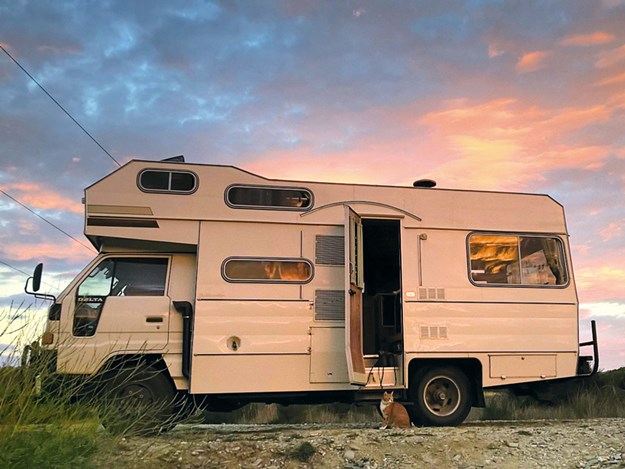
It’s Tom-Tom’s bachelor pad. I made a harness and lead, so we can all go walking and hill climbing. Tom-Tom’s been to the North Island and all over the South Island too."
- AJ Wilson (near Oamaru).
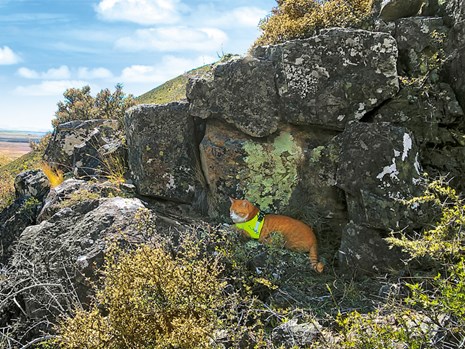 |
Tom-Tom exploring |
Follow Wanderer and Ebony on Facebook at facebook.com/wandererkitten/
Top tips from the New Zealand Veterinary Association (NZVA)
- Don’t leave pets inside parked vehicles on hot days (it’s an obvious but important reminder).
- Buckle up your dog with a seat belt and keep your cat or rabbit in a cage while you’re moving. “This is for their own safety should there be an accident and means your pet won’t distract the driver,” says Dr Helen Beattie, Chief Veterinary Officer.
- Give your fur babies adequate shade and shelter at each destination. “Some people take temporary fencing to put around their caravan or motorhome, which can be an effective safety barrier,” says Helen.
- Keep vaccinations up to date. NZVA recommends the leptospirosis vaccination for pets travelling to the North Island. “With rabbits, we definitely recommend a RHDV/Calicivirus shot regardless of your destination. If you’re going near or on a farm, do get your dog wormed.” Talk to your vet for more information about vaccines.
- Keep litter boxes well stocked and handy and pack plenty of doggy-do bags for when you’re parked up.
|
Many cats love exploring new places and take to travel well when introduced to it at an early age |

